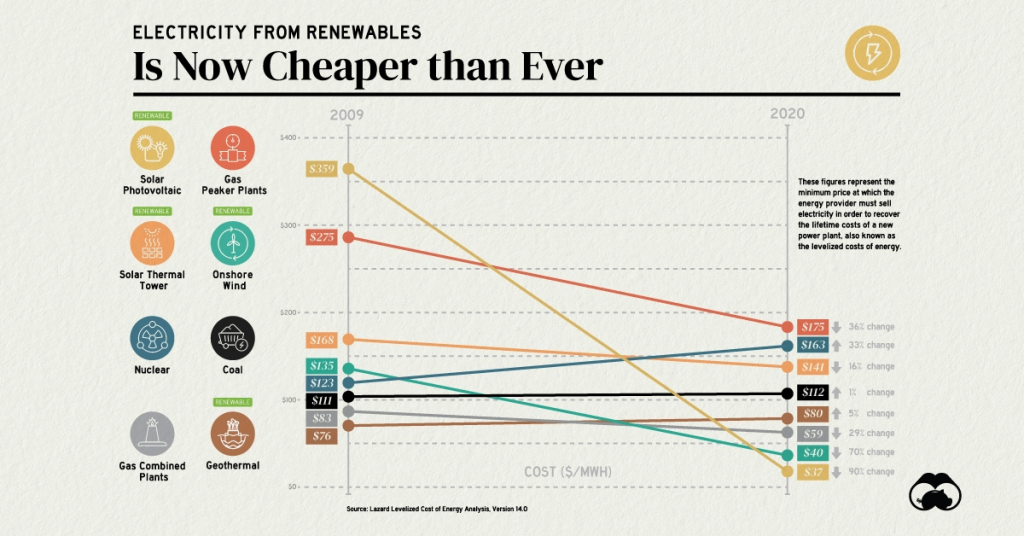The Problem With Levelized Costs and Overusing Them

Last week, we introduced a chart published by Energy Innovation Policy highlighting that, according to their research, the cost of building new wind and solar facilities across the US was more economic than maintaining existing coal-powered assets. This used a popular measure known as the levelized cost of energy (LCOE).
You better believe that our passionate, well-read readers wrote in to highlight some of the flaws with LCOE numbers. This is for all of you. Keep sending us those emails, we love it.
What is LCOE?
The levelized cost of energy or levelized cost of electricity (LCOE), is metric commonly used to compare the costs of different types of technologies that create electricity and other types of energy.
- For those curious, it’s the total lifetime costs divided by total lifetime energy output. The result is a cost-per-unit-of-energy comparison that theoretically shows you which energy sources are more economic.
In recent years, the LCOE of wind and solar have been popularized as they’ve dropped significantly, often below most types of fossil fuel projects. And if LCOE was all that mattered, then every sanctioned project moving forward would be solar… but they aren’t cause it isn’t.
Levelized cost of energy, 2009-2020

LCOE: One Size Does Not Fit All
The main problem with levelized costs is not necessarily the formula itself, but when levelized costs are used to make broad sweeping statements about which energy generation technology is “best”. While one technology may be better than others in some regions and under specific circumstances, every demand center has different needs, different resources, and every power grid has different capabilities.
- Communities in the Artic Circle have a very different relationship with the regularity of the Sun than communities on the equator do.
The Wu-Tang Clan of energy metrics
If LCOE was a song, it would be Cash Rules Everything Around Me. But when it comes to power generation, the cost to create the electricity is only one piece of the puzzle.
By reducing an entire energy system down to a single number, the levelized cost metric ignores whether a source is intermittent, seasonal, or able to provide baseload power.
- Power facilities that are stable, predictable, and can be scaled with demand are more valuable for grid operators than those that can’t, but levelized costs don’t ascribe any additional value to those that can.
You can’t build a full energy system on intermittent power
For building a full energy system, to truly have an apples-to-apples comparison, intermittent and seasonal electricity sources would need to add additional costs for storage on top of their levelized costs (also know as the levelized cost of storage).
- For reference, adding grid-scale storage to wind or solar power would increase their costs 5-6x. Battery costs are coming down, but remain prohibitively high, not to mention that long-duration, grid-scale batteries aren’t really a thing yet.
2021 levelized cost of energy comparison, unsubsidized
dollar per megawatt-hour

Many of the inputs costs also require peering into the crystal ball to guestimate the lifetime fuel and material costs from natural gas, coal, critical minerals, and more.
- If anyone has a reliable way to predict commodity prices, please let us know. Asking for a friend.
With great power (you’re welcome) comes great responsibility
To be clear, when used responsibly, LCOE is a useful metric that can help guide investment decisions. Understanding and comparing the lifecycle economics of a wind farm to a nuclear facility is a perfectly reasonable thing to do.And cheap solar today will help make electricity cheaper and cleaner, as there is plenty of expensive, carbon-intensive power sources that can be displaced well before batteries are needed.
Bottom line: All energy is not created equal. Despite theoretically favorable LCOEs, wind and solar are not perfect substitutes for stable, scalable power sources. In today’s world, renewables produce power when they can and conventionals step in when they can’t, ensuring we can all watch whenever the world’s largest football game is interrupted by a Rhianna concert.
In the end, LCOE is an insightful metric that needs to be balanced by other valuable, intangible considerations before conclusions can be drawn.
+Additional reading: Lazard LCOE Version 15 (2021)
++Additional reading: The Coal Cost Crossover 3.0




